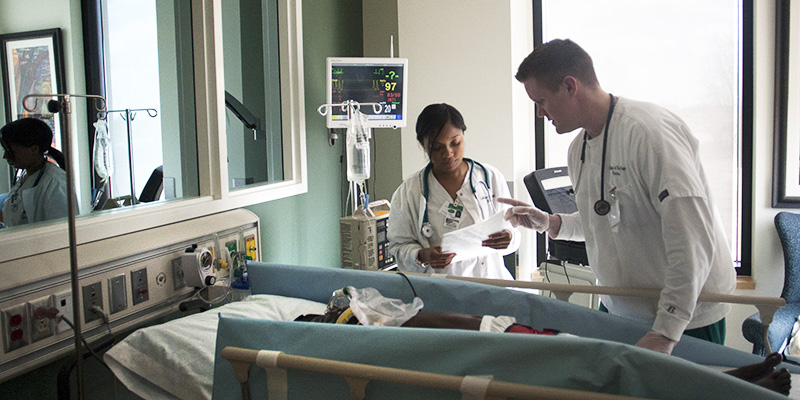
(Photo: CODNewsroom/Flickr)
Originally published on Center for Health Journalism.
For a growing share of Americans, the future of work includes taking care of people. Health care occupations are expected to add about 1.9 million jobs nationwide between 2018 and 2028, faster than the average for all occupations. This is mostly due to an aging population of Americans over 65, since seniors use more health services than any other group.
The result is an increased demand for what is often referred to as the hidden health care workforce, whose services are critical to delivering high-quality health care. These jobs include clinical, administrative and support professionals such as medical assistants, medical coders, health IT technicians, and laboratory workers.
Right now, there are not enough skilled workers to meet the growing demand. This is due to a lack of awareness about these health care jobs, a lack of affordable education, inadequate lab space and clinical slots for students to meet licensure requirements, and a lack of clear upward mobility for workers. In California alone, there is an expected demand for almost 450,000 new allied healthcare workers through 2024.
The need for more health care workers is a structural issue that no one entity can solve on its own. Organizations need to take a different approach and not just reuse the old strategies. An ecosystem must come together to solve obstacles and frictions in the student journey.
This is what the organization I lead, Futuro Health, is aiming to do as it sets out to grow the number of credentialed health care workers, starting in California. The nonprofit was established this year with a $130 million commitment by Kaiser Permanente and Service Employees International Union-United Healthcare Workers West (SEIU-UHW).
Raising awareness, providing affordable education
For health care workers to reflect the communities they serve, education needs to be available and attainable.
Getting into communities and increasing awareness for these careers is critical to tackling the shortage of workers. One way my organization is doing this is by collaborating with SEIU-UHW and tapping into its nearly 100,000 members, who primarily work in hospitals.
These union members will scout and recruit quality applicants, and then mentor students while they pursue their credential. Part of the mentoring involves identifying whether candidates are a good fit with the occupations that comprise 70% of the demand for the allied health workers needed in California. The other piece is coaching them about career and education paths.
In a number of focus groups conducted by SEIU-UHW, even workers who have gotten into high-demand health careers find it hard to move up because they are overburdened by student debt.
Figuring out how people can obtain their first credential to get into the industry, and financing the education required by more advanced roles, is key to building a skilled health care workforce — especially for diverse and underrepresented populations.
Boosting lab space and clinical slots
Health care is a highly credentialed industry, and licensure bodies set requirements that shape the work of education and training providers. For most occupations, students need to complete academic coursework but are also required to practice skills in labs, followed by clinical training where they care for actual patients under supervision.
The president of MiraCosta College in San Diego County estimates that she could triple the number of students and clear wait lists for her community college’s licensed vocational nursing program if there were more clinical slots available. Western Governors University, a national accredited university, was only able to start a new medical assistant program when Kaiser Permanente and SEIU-UHW stepped in to help refurbish unused buildings with medical office gear to use for lab spaces.
More industry collaborations like this will be necessary if we’re going to boost the number of workers in sorely needed health care jobs. It’s clear that regional strategies are needed to help education providers, especially those with smaller budgets, increase their capacity to serve students. But we can’t only focus on the present workforce needs.
If we know that the future of care is moving out of the hospital and into the home, we need to start thinking about what new skillsets workers will need. For example, licensed vocational nurses will not only need patient care training but likely need IT skills to work with sensors and devices worn by patients and to videoconference with doctors to provide patient care as a team. They will also need to be adept at navigating in a patient’s home.
Addressing the needs of the graying and growing population will continue to be top of mind. But when it comes to workforce development, it’s important to look around the corner in order to stay ahead.
Van Ton-Quinlivan is the CEO of Futuro Health, executive vice chancellor emerita of the California Community Colleges, and a nationally recognized thought leader in workforce development. She was named California Steward Leader, White House Champion of Change by the Obama Administration, and mediaX Stanford Distinguished Visiting Fellow. Follow her at @WorkforceVan.

